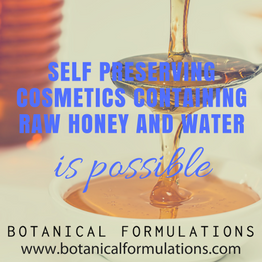Self preserving cosmetics containing raw honey and water is possible
When I formulated the Gentle Honey Cleanser I was in no doubt that it was self preserving and stable. I had been researching preservation for a very long blog post at the time, focusing on various strategies for maintaining a fresh and clean product.
I had also been reading about honey and how it is used in cosmetic products, primarily because I wanted to copy Lush's 'Fair Trade Honey', one of my favourite products of all time.
Looking at the ingredients list for this product, it seemed like a faff and would include heating the product or some of the ingredients. That didn't appeal to me. However, a combination of researching preservation and honey created a light bulb moment where it was possible to create a similar product that could be cold processed, super simple, and self preserving.
The theory was that if all the ingredients are self preserving with some aiding preservation, and included at the right ratio, then the end product would be too.
I put the formulation on the market. It has been a best seller for me. However it has been controversial. Straight away I had questions about preservation. People, including those that bought the product, questioned the lack of preservative. Some people publicly challenged the formulation and implied that it was 'unsafe'.
There is also a lot of misinformation about the use of a preservatives. There are many people that use the 'just in case' method where they may use a conventional preservative in a product that does not need one, this can be due to limited knowledge, lack of confidence or because they don't, for whatever reason, want testing done.
Over preserving can be as dangerous as under- preserving. There are are also people that think any amount of water in a product means it needs a preservative. This is not the case.
I have always told people they need to take responsibility for their products, especially if they are bringing them to market and advise that I can not comment on their business model; if they feel the need for a preservative then they make that judgement call, they need to do their research and make a decision. I do advise that to be safe they need the necessary testing.
Due to the misinformation and concerns raised, I decided to get a third party safety assessor to look over my formulation. I could at last put this issue to rest. In the EU we are required to keep a Product Information File as part of the European Union Cosmetic Regulations. A large part of this is the Cosmetic Product Safety Report (CPSR). This is a detailed analysis of the product and all the ingredients, packaging and how they are likely to interact with the end user. The safety assessor has to be suitably qualified in their field. They also advise on whether a challenge test and stability test is needed. They will not complete a CPSR if it needs either or both of these tests.
I sent the full formulation, including methods and packaging advice to my safety assessor and asked her whether it required a preservative and a preservative efficacy test (PET.) Her advice was that due to the self preserving nature of the ingredients and the percentage they are in the product, it did not need a challenge test and did not need a conventional preservative. She would be able to do a complete CPSR on this product which would allow it to be bought to market pretty quickly. This was just as I thought, but it was good to get an independent opinion and I wish I had done so sooner. If there are any people who purchased the Gentle Honey Cleanser, and would like to get a CPSR to allow them to sell in the EU, please contact me and I can give you my safety assessors details.
If you want to find out more about the Gentle Honey Cleanser, please follow the link below.


